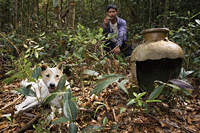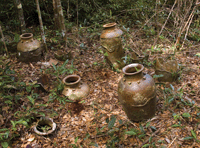
Posted on 04/06/2007 2:37:36 PM PDT by blam
Forest of Broken Urns
Volume 60 Number 2, March/April 2007
by Karen J. Coates
Borneo's unexplored past is dying by the chainsaw.

Tony Paran sits near a jar that held the remains of one of his ancestors. Soon, the forests that shelter these jars will be logged. (Jerry Redfern)
Walter Paran was a lucky boy. Three minutes out his front door lay an old grave in the forest marked by big stone slabs, a broken jar, and human bones. A few minutes another way was a pit where the riches of the dead were purportedly buried. What more could an inquisitive kid want?

More than a dozen burial jars sit in this clearing in Borneo's Kelabit Highlands. (Jerry Redfern)
Back then, in the 1970s, Paran didn't know much about archaeology. He had heard that the burial site, Batu Ritong, held the remains of a prominent ancestor. He and his friends cautiously explored the forest around the stone-slab enclosures and large ceramic jars. "We were afraid when we came here." Superstition mixed with curiosity.
Paran grew up in the Kelabit Highlands of Malaysia's Sarawak state. For centuries, the Kelabit people have lived deep in Borneo's upland jungles, practicing animism and headhunting until missionaries converted them to Christianity after World War II. Before then, the Kelabits erected megalithic monuments such as Batu Ritong. They also built separate memorials where the deceased's belongings were buried. Paran took us to such a place on the other side of his village. It consists of a couple of big stone slabs propped on boulders, covering dozens of small stones and an ancestor's belongings in the ground. Villagers do not dig up the valuables, Paran says, "otherwise your life is not nice."
Paran worries about these sites. Much of the Kelabit Highlands is slated for logging, and Paran fears Kelabit relics and features will perish by axes and bulldozers before archaeologists can study them.
"As yet, no proper archaeological work has been done in the Kelabit Highlands," says Monica Janowski, a University of Greenwich, England, anthropologist. She is part of a research team that will map and investigate highlands archaeology, and trace the relationship between people and the environment through time.
Karen J. Coates is a freelance writer based in Cambodia.
I'm reminded of the Plain Of Jars In Laos.

Location of Plain of Jars and Xieng Khouang plain (blue shading).
Have you ever heard of “the plain of jars”? I think it’s in Thailand. It sounds like a similar thing.
I guess you have. LOL
Get some Lilly white, college anthropology major, unpaid intern kids to document/recover the remains.
They really love that stuff.
The more PC they are, the more they believe that, as scientists, they're justified to mess with anybody's "final resting place". Even when the cultures they supposedly revere don't want them to do it.
"Screw 'em, we're highly educated white scientists" is their motto.
/wasted 10 years of my life in "Cultural Resources Management".
Please FREEPMAIL me if you want on or off the
"Gods, Graves, Glyphs" PING list or GGG weekly digest
-- Archaeology/Anthropology/Ancient Cultures/Artifacts/Antiquities, etc.
Gods, Graves, Glyphs (alpha order)
How do YOU tend your dead?
|
|
|||
Gods |
Just updating the GGG info, not sending a general distribution. |
||
|
· Discover · Nat Geographic · Texas AM Anthro News · Yahoo Anthro & Archaeo · · The Archaeology Channel · Excerpt, or Link only? · cgk's list of ping lists · |
|||
Disclaimer: Opinions posted on Free Republic are those of the individual posters and do not necessarily represent the opinion of Free Republic or its management. All materials posted herein are protected by copyright law and the exemption for fair use of copyrighted works.